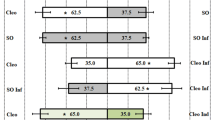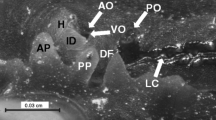Abstract
Oribatid mites (Acari, Oribatida) represent one of the most abundant and speciose groups of microarthropods in the decomposer food webs of soils, but little is known of their top-down regulation by predators. Oribatids are relatively long-lived and have numerous morphological defensive adaptations, and so have been proposed to live in ‘enemy-free space’. Most also possess a pair of large exocrine oil glands that produce species-specific mixtures of hydrocarbons, terpenes, aromatics, and alkaloids with presumably allomonal functions, although their adaptive value has never been tested empirically. We developed a protocol that discharges the oil glands of the model oribatid species, Archegozetes longisetosus. and offered ‘disarmed’ individuals as prey to polyphagous Stenus beetles (Staphylinidae), using untreated mites as controls. Stenus juno fed on disarmed mites with behavioral sequences and success rates similar to those observed when they prey on springtails, a common prey. In contrast, mites from the control group with full glands were almost completely rejected; contact with the gland region elicited a strong reaction and cleaning behavior in the beetle. This is the first evidence of an adaptive value of oribatid mite oil gland secretions for chemical defense. The protocol of discharging oil glands should facilitate future studies on top-down control of oribatid mites that aim to differentiate between morphological and chemical aspects of defensive strategies.


Similar content being viewed by others
References
Alberti, G., Heethoff, M., Norton, R. A., Schmelzle, S., Seniczak, A., and Seniczak, S. 2011. Fine structure of the gnathosoma of Archegozetes longisetosus Aoki (Acari: Oribatida, Trhypochthoniidae). J. Morphol., in press. doi: 10.1002/jmor.10971.
Betz, O. 1998. Comparative studies on the predatory behaviour of Stenus spp. (Coleoptera: Staphylinidae): the significance of its specialized labial apparatus. J. Zool. Lond. 244:527–544.
Betz, O., Koerner, L., and Gorb, S. 2009. An insect’s tongue as the model for two-phase viscous adhesives? Adhesion 3:32–35.
Eisner, T. 2003. For Love of Insects. Harvard University Press, Cambridge.
Eisner, T., Alsop, D., and Meinwald, J. 1978. Secretions of opilionids, whip scorpions, and pseudoscorpions, pp. 87–99, in S. Bettini (ed.), Arthropod Venoms, Handbook of Experimental Pharmacology. Springer, Berlin.
Eisner, T., Eisner, M., Attygalle, A. B., Deyrup, M., and Meinwald, J. 1998. Rendering the inedible edible: circumvention of a millipede’s chemical defense by a predaceous beetle larva (Phengodidae). Proc. Nat. Acad. Sci. USA 95:1108–1113.
Eisner, T., Meinwald, J., Monro, A., and Ghent, R. 1961. Defence mechanism of arthropods - I. The composition and function of the spray of the whipscorpion, Mastigoproctus giganteus (Lucas) (Arachnida: Pedipalpida). J. Ins. Phys. 6:272–298.
Heethoff, M. and Koerner, L. 2007. Small but powerful: The oribatid mite Archegozetes longisetosus Aoki (Acari, Oribatida) produces disproportionately high forces. J. Exp. Biol. 210:3036–3042.
Heethoff, M. and Norton, R. A. 2009. Role of musculature during defecation in a particle-feeding arachnid, Archegozetes longisetosus (Acari, Oribatida). J. Morphol. 270:1–13.
Heethoff, M. and Raspotnig, G. 2011. Is 7-hydroxyphthalide a natural compound of oil gland secretions?—Evidence from Archegozetes longisetosus (Acari, Oribatida). Acarologia 51:229–236.
Heethoff, M. Laumann, M., and Bergmann, P. 2007. Adding to the reproductive biology of the parthenogenetic oribatid mite, Archegozetes longisetosus (Acari, Oribatida, Trhypochthoniidae). Turk. J. Zool. 31:151–159.
Heethoff, M., Laumann, M., Weigmann, G., and Raspotnig, G. 2011. Integrative taxonomy: Combining morphological, molecular and chemical data for species delineation in the parthenogenetic Trhypochthonius tectorum complex (Acari, Oribatida, Trhypochthoniidae). Front. Zool. 8:2.
Heethoff, M., Norton, R. A., Scheu, S., and Maraun, M. 2009. Parthenogenesis in oribatid mites: Evolution without sex, pp. 241–257, in I. Schön, K. Martens and P. van Dijk (eds.). Lost Sex. Springer, Dordrecht.
Masuko, K. 1994. Specialized predation on oribatid mites by two species of the ant genus Myrmecina (Hymenoptera: Formicidae). Psyche 101:159–173.
Mollemann, F. and Walter, D. E. 2001. Niche segregation and can-openers: Scydmaenid beetles as predators of armoured mites in Australia, pp. 281–288, in R. B. Halliday, D. E. Walter, H. C. Proctor, R. A. Norton and M. J. Colloff (eds.). Acarology: Proceedings of the 10th International Congress. CSIRO Publishing, Melbourne.
Norton, R. A. 2007. Holistic acarology and ultimate causes: examples from the oribatid mites, pp. 3–20, in J. B. Morales-Malacara, V. Behan-Pelletier, E. Ueckermann, T. M. Perez, E. G. Estrada-Venegas and M. Badii (eds.). Acarology XI: Proceedings of the International Congress. Sociedad Latinoamericana de Acarologia, Mexico.
Norton, R. A. and Macnamara, M. C. 1976. The common newt (Notophthalmus viridescens) as a predator of soil mites in New York. J. Entomol. Soc. Georgia 11:83–88.
Oudemans, A. C. 1916. Notizen über Acari, 25. Reihe (Trombidiidae, Oribatidae, Phthiracaridae). Arch. f. Naturgesch. 6:1–84.
Peschel, K., Norton, R. A., Scheu, S., and Maraun, M. 2006. Do oribatid mites live in enemy-free space? Evidence from feeding experiments with the predatory mite Pergamasus septentrionalis. Soil Biol. Biochem. 38:2985–2989.
Raspotnig, G. 2006. Chemical alarm and defence in the oribatid mite Collohmannia gigantea (Acari: Oribatida). Exp. Appl. Acarol. 39:177–194.
Raspotnig, G. 2010. Oil gland secretions in Oribatida (Acari), pp. 235–239, in M. W. Sabelis and J. Bruin (eds.). Trends in Acarology. Springer, Dordrecht.
Raspotnig, G. and Leis, H. -J. 2009. Wearing a raincoat: exocrine secretions contain anti-wetting agents in the oribatid mite, Liacarus subterranaeus (Acari: Oribatida). Exp. Appl. Acarol. 47:179–190.
Raspotnig, G., Leutgeb, V., Schaider, M., and Komposch, C. 2010. Naphthoquinones and anthraquinones from scent glands of a dyspnoid harvestman, Paranemastoma quadripunctatum. J. Chem. Ecol. 36:158–162.
Raspotnig, G., Leutgeb, V., Krisper, G. and Leis, H. -J. 2011a. Discrimination of Oribotritia species by oil gland chemistry (Acari, Oribatida). Exp. Appl. Acarol. 54:211–224.
Raspotnig, G., Norton, R. A., and Heethoff, M. 2011b. Oribatid mites and skin alkaloids in poison frogs. Biol. Lett. in press. doi: 10.1098/rsbl.2010.1113.
Roach, B., Eisner, T., and Meinwald, J. 1980. Defensive substances of opilionids. J. Chem. Ecol. 6:511–516.
Rodriguez, A., Poth, D., Schulz, S., and Vences, M. 2010. Discovery of alkaloids in miniaturized eleutherodactylid frog from Cuba. Biol. Lett. 7:414–418.
Sakata, T. and Norton, R. A. 2001. Opisthonotal gland chemistry of early-derivative oribatid mites (Acari) and its relevance to systematic relationships of Astigmata. Int. J. Acarol. 27: 281–291.
Sanders, F. H. and Norton, R. A. 2004. Anatomy and function of the ptychoid defensive mechanism in the mite Euphthiradarus cooki (Acari: Oribatida). J. Morphol. 259:119–154.
Schaefer, I., Norton, R. A., Scheu, S., and Maraun, M. 2010. Arthropod colonization of land—Linking molecules and fossils in oribatid mites (Acari, Oribatida). Mol. Phyl. Evol. 57:113–121.
Schmelzle, S., Helfen, L., Norton, R. A., and Heethoff, M. 2009. The ptychoid defensive mechanism in Euphthiracaroidea (Acari: Oribatida): A comparison of muscular elements with functional considerations. Arth. Struct. Dev. 38:461–472.
Schneider, K. and Maraun, M 2009. Top-down control of soil microarthropods—Evidence from a laboratory experiment. Soil Biol. Biochem. 41:170–175.
Shimano, S., Sakata, T., Mizutani, Y., and Kuwahara, Y. 2002. Geranial: The alarm pheromone in the nymphal stage of the oribatid mite, Nothrus palustris. J. Chem. Ecol. 28:1831–1837.
Wauthy, G., Leponce, M., Bana, N., Sylin, G., and Lions, J.C. 1998. The backward jump of a box moss mite. Proc. Roy. Soc. B 265:2235–242.
Acknowledgements
MH is funded by the German Science Foundation (DFG-Forschungsstipendium HE4593/3-1). GR was supported by the Austrian Science Funds (FWF), projects P18486-B16 and P21819-B16.
Author information
Authors and Affiliations
Corresponding author
Electronic Supplementary Material
Rights and permissions
About this article
Cite this article
Heethoff, M., Koerner, L., Norton, R.A. et al. Tasty but Protected—First Evidence of Chemical Defense in Oribatid Mites. J Chem Ecol 37, 1037–1043 (2011). https://doi.org/10.1007/s10886-011-0009-2
Received:
Revised:
Accepted:
Published:
Issue Date:
DOI: https://doi.org/10.1007/s10886-011-0009-2




